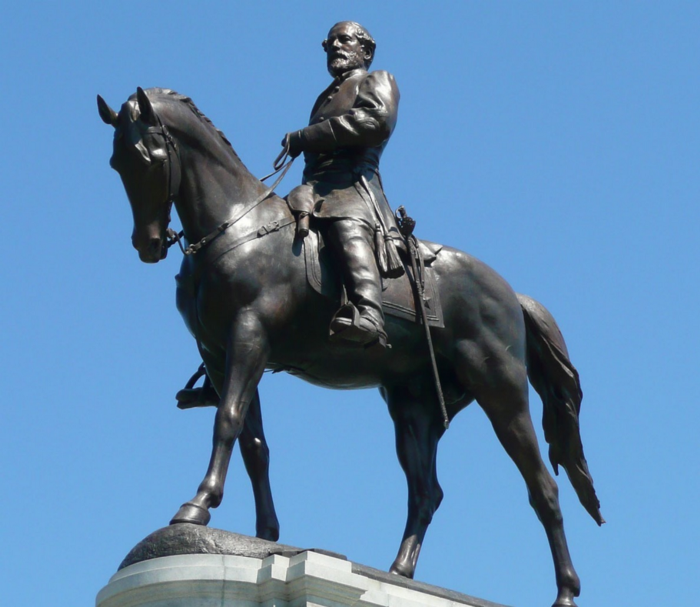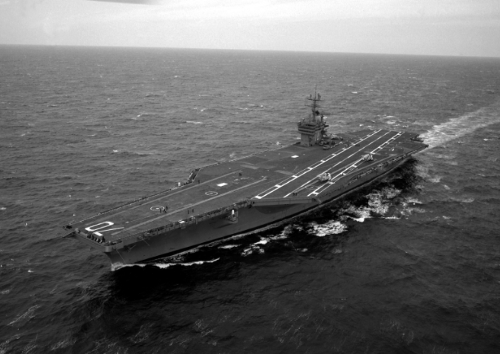Republished with permission of Edward Anthony Moore III

There has been a lot of debate about whether or not we should be tearing down statues of Confederate leaders or renaming government institutions and facilities named after historic segregationists. Are we destroying monuments to racism or are we erasing important parts of our history? Let me tell you a short story and then I’ll let you decide.
Carl Vinson served in the U.S. House of Representatives, representing Georgia’s 10th congressional district, from 1914 to 1965. He is sometimes referred to as the “Patriarch of the Armed Forces,” though he never served in the military, due to his role on various Armed Forces committees in the House and the logistical innovations that occurred during his service.
Vinson was a staunch segregationist. He signed “The Southern Manifesto” in 1956, with a slew of other Southern politicians, in resistance to the Supreme Court ruling on “Brown v. Board of Education” that deemed segregated public schools unconstitutional. He retired from Congress in 1965, declining to seek reelection in 1964, the same year the Civil Rights Act was passed.
In 1980, the United States Navy commissioned its third Nimitz-class Aircraft Carrier, no less than a floating city, the pinnacle of our military might. They named it the USS CARL VINSON (CVN-70).

In 1956, as Congressman Vinson was applying his John Hancock to the “The Southern Manifesto,” an ambitious 11-year-old Black boy was attending Dunbar Junior High School in Little Rock, Arkansas. The next year, the Little Rock Nine would be the first black students to enroll at the formerly all-white Central High School, beginning the long and arduous road of desegregation, much to Vinson’s chagrin.
This young boy, still in junior high school, was friends with the younger siblings of much of the Little Rock Nine and was able to hear first-hand accounts of the tribulations they were facing as they walked those whitewashed hallways. Tales of needing an elite armed guard, military jeeps, and helicopters to go to and from school. Tales of being openly abused and defamed while the abusers faced no consequences or retribution. Tales of receiving C grades for A papers, despite putting in twice as much time and producing higher quality work than white students who received better marks.
In the next few years, this young boy would face a difficult decision. Either enter the fray of being one of those select few Black students permitted to enter a higher quality school on a limited basis and immerse himself in a hotbed of blatant racism and violent tension while being forced to constantly exercise restraint of tongue and fist, not retaliate and likely accept grades below the marks he’d earned, or attend the separate but not equal Horace Mann High School with a Black teaching staff who was invested in his future, supportive of his goals and would grade his work on merit. He chose the latter. He had a goal and C’s just would not cut it.
He would graduate from Horace Mann in 1963 with stellar grades and submit his first application to the U.S. Naval Academy. It was denied. He pressed on, attending Southern Illinois University and applied to the Naval Academy again after his freshman year there. Once more he was denied. The young man confronted the realization that both his State Senators and the congressional representative from his home district were unlikely to appoint a young Black man to the prestigious academic institution meant to train and groom future Officers. There had been progress, but not that much. He had already enlisted in the U.S. Naval Reserve, so he would make his way as an enlisted man. A young, Black enlisted man in the good-ole-boys Navy of the time.
This began the storied career of Vice Admiral Edward Moore Jr.
Admiral Moore would go on to serve his country in the Vietnam War, serve as Gunnery Officer, Communications Officer, Operations Officer, Navigator and earn a Master’s degree in Business Administration from U.S. Naval Postgraduate School. He would become a Junior Assignment Officer and Shore Assignments Coordinator at the Bureau of Naval Personnel. He was then assigned to the USS BUCHANAN (DDG-14) as Executive Officer in 1979 and served as the second Commanding Officer of the USS LEWIS B. PULLER (FFG-23) before being promoted to Captain and first Commanding Officer of the Ticonderoga-class guided-missile cruiser the USS COWPENS (CG-63). As the first Black Captain of an Aegis Class Cruiser, he led a successful Tomahawk missile strike against a sensitive target in Iraq.
Admiral Moore would end his 38-year career as the highest-ranking Black officer in the Navy, a 3-Star Admiral retiring as Commander, U.S. Naval Surface Forces, Pacific.

During those 38 years he was awarded the Navy Distinguished Service Medal, Legion of Merit Medal with four gold stars, the Defense Meritorious Service Medal, the Meritorious Service Medal, the Navy Achievement Medal, and many other service and campaign awards. He also made significant contributions in pioneering systems integration aboard ships as the Navy ushered in a new era of technological advancement. Moore pioneered many things, not the least of which was an unprecedented avenue to the Flag Officer rank from enlisted service. Where the progress of society lagged behind his vision, he made his own path and cleared the way for those who came after him.
In 1995 when he assumed command of Cruiser-Destroyer Group Three, his flagship was the USS CARL VINSON. He defied the odds and rose the ranks through the barriers of discrimination and then, as Task Force Commander, stood aboard a floating fortress named in commemoration of the man who had so adamantly opposed his equality; a monument to someone who fought tooth and nail to try to prevent him -and anyone who looked like him- from ever assuming such a command, or going to a decent school, from ever riding in the front of the bus, or eating in the same restaurants as white people. Carl Vinson spent his 51 years of service devoted to the belief, in word and action, that Vice Admiral Edward Moore Jr. was a second class citizen.
Vice Admiral Edward Moore Jr. is my father.
I have stood on the CARL VINSON as my father stepped aboard and hundreds of men and women jumped to attention and saluted to the announcement, “Admiral on deck!” I have walked the passageways of that ship with him as young, Black sailors stepped out on a limb and broke rank to take the opportunity to thank him from the bottom of their hearts for paving the way ahead of them, with joyous smiles and reverent souls. I’ve watched thousands of brave men and women of every color and creed who have served this country at the highest level, offer this man the utmost respect for his service and devotion to this Nation and for leadership that changed their lives.
I didn’t really know who Carl Vinson was until last week. My father never mentioned it. I walked the passageways, climbed the ladders, and stood on the deck of that ship as a child in awe of his father — without ever really knowing the poetry of the triumph written by determination and fate as he assumed command and stepped aboard. A story, that upon closer examination, seems to be written by the hand of Justice itself.
So you tell me, who should the ship be named after? Who deserves a monument? Whose stories and ideals should we enshrine in our statues, our ships, our military bases, and our Capitol buildings? The great men and women of this country who defied the odds and triumphed over evil, doing so in service to all Americans? Or those who strove to preserve the evil of racism at the expense of so many of those heroes?
My father cried when he retired. My father loves the Navy. He loves this country as too few do, in action and above his own life. Is it not time his country, at minimum, respect him and the 13% of the population with black skin enough to remove the state-sponsored glorification of those who fought to try and ensure we could never be truly free?
Trust me, we will not forget our history because 10-foot statues of bigots do not loom in public squares. We will not forget slavery because traitors to the Union don’t have bases and war vessels in their names. We will not forget segregation because those who fought to preserve it are no longer celebrated as icons of the country they strove to divide.
My Father never brought up Vinson’s history. When I realized what I had missed, I called him to talk about it. I sheepishly asked if he knew Carl Vinson’s history, knowing it was a silly question. Do you know what he said? “Yea, Carl Vinson certainly turned over in his grave when that ship became my Flagship.” He always knew and he never mentioned it. His life and his career said every word there was to say on the matter.
So you tell me, who should that ship be named after?





